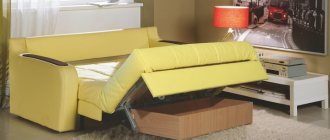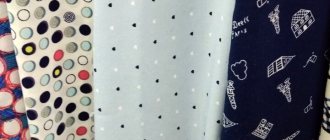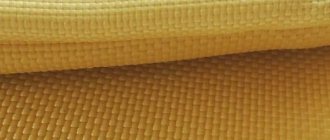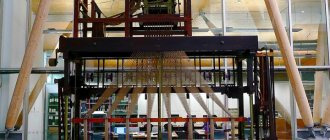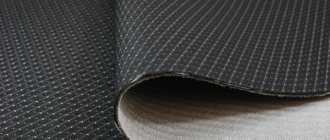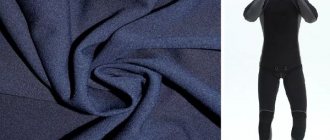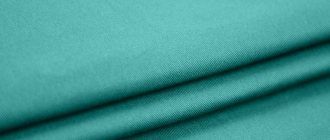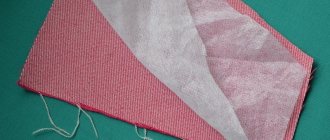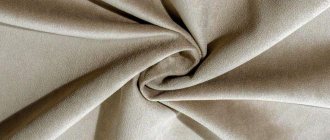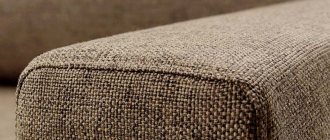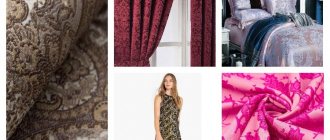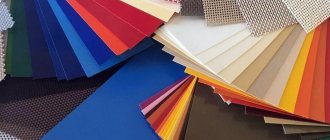| What is it called differently: | jacquard |
| Natural or synthetic? | can be natural, synthetic, combined |
| How does it feel? | beautiful, with a relief pattern, pleasant to the touch |
| Application: | clothing and accessories, table and bed linen, curtains, furniture upholstery |
| Fabric structure: | complex weave of threads called jacquard |
| Does it stretch or not? (Extensibility) | depending on the type, it can be very elastic or slightly stretchable |
| Recommended washing temperature: | not higher than +30 °С |
| Washing mode: | gentle |
| Press: | spinning is not advisable |
| Kinds: | cotton, satin, stretch jacquard, satin jacquard, jersey jacquard |
| Presence of shine: | depending on the type, it may have a surface with or without a glossy sheen |
| Degree of creasing: | low |
| Edge fraying: | crumbles to varying degrees depending on the composition of the fabric |
| Hygroscopicity: | high |
| Drapability: | flows, gently drapes, forms beautiful folds |
| Ability to keep warm: | good |
| Shrinkage: | rarely shrinks |
| Breathability: | good |
| Fade or not: | the material is not prone to fading |
The machine for the production of fabric with relief weaving was created by a weaver from Lyon, Joseph Marie Jacquard, and the material was named after him. What kind of fabric is this - jacquard? Smooth and pleasant to the touch fabric, which is obtained thanks to a special weave of threads. To create a pattern, threads of different shades are used; in some cases, the pattern is applied later, when the fabric has already been woven.
Jacquard fabric, Prada line
Description
Jacquard is not cheap due to the complexity of the production process. The main feature of woven patterns is that there is a very large number of threads per unit surface, which determines the specific properties of the material. Fabric description:
- a distinct pattern, often three-dimensional;
- attractive appearance;
- crease resistance;
- ease.
The composition of jacquard includes artificial or natural fibers, as well as their combination. How much the fabric will weigh depends on the thickness of the fibers that make up it and on the number of shades that form the pattern. The two-color material, despite its high density, is lightweight and easy to care for. Usually the number of multi-colored threads reaches ten to create a complex pattern - 100 or more.
Application area
Original ornaments and complex patterns appear in clothing, interior items and accessories. Jacquard ribbon is suitable for finishing products. When making winter clothes, you will need jacquard knitting. Tapestry drawings are suitable for decorating the interior with paintings and panels.
Jacquard car covers will be a gift for a motorist. A jacquard tablecloth or bedspread will be a pleasant surprise for the hostess. In interior design in baroque or classic style, curtains or jacquard curtains would be appropriate. The design on the fabric can be complex and unusual, or simple and emphatically naive. For example, hearts will be used to decorate a children's blanket. The baby sling will be decorated with plant-themed patterns, ethnic ornaments and drawings in the naive style.
Advantages and disadvantages
Jacquard fabric has only one drawback - high cost. At the same time, fabric made from natural fibers is more expensive than synthetic ones.
Jacquard knitwear
Advantages:
- increased strength;
- high wear resistance;
- resistance to temperature changes;
- ease of care.
The scandalous appearance of a relief pattern
In 1801, thanks to Joseph Jacquard, the world learned about a new technology for making fabric. This French inventor invented a machine on which it was possible to create fabric with three-dimensional and colored patterns. Since then, this fabric has been produced on an industrial scale.
Napoleon especially admired the jacquard fabric. He assigned Joseph Jacquard a bonus and a pension, which were to be awarded for each working machine. However, such an invention also had negative sides - thousands of artisans were left without jobs, which led to a great uprising, but even this did not serve as an obstacle to the production of fabric.
Joseph Jacquard and his machine
Kinds
Jacquard fabrics come in several varieties, the most common are:
- Cotton - it contains cotton, often mixed with synthetic fibers. The thickness and texture can be different, depending on them, decorative textiles, upholstery materials, and clothing items are made from cotton jacquard.
- Satin is used as a raw material for sewing luxury bed linen. Satin jacquard is made on a cotton base with the addition of synthetic threads.
- Stretch is a jacquard made of elastic synthetic threads; the material has excellent stretch and breathability. The fabric is used for sewing clothes and making orthopedic mattresses.
- Satin jacquard made of synthetic polyester fibers. Serves as an ideal raw material for sewing curtains and various decorative textiles. The fabrics do not wrinkle, do not shrink when washed, and are easy to care for.
- Jacquard knitwear is used as a raw material for sewing warm clothes: sweaters, coats, jackets, suits, dresses, skirts.
Dense jacquard fabric
Technical characteristics and composition determine the properties and purpose of jacquard fabrics:
- fine fabric made from natural fibers, used for sewing high-quality clothing and bed linen;
- jacquard based on synthetic fibers, characterized by high density, is used as curtains, curtains and decorative material;
- For upholstery, the densest type of jacquard is used, with a special impregnation, which is necessary to facilitate the care of furniture.
What is jacquard made from?
In the old days, fabric with woven patterns was made from natural fibers - in most cases, these were cotton, linen, wool and silk. Nowadays, such materials from raw materials of natural origin are also produced, but a significant part of the items of modern weaving factories are fabrics containing synthetic fibers. We are accustomed to the fact that natural fibers are valued much higher than artificial ones, but the addition of lycra fibers to jacquard fabric makes the material elastic, breathable and easy to use and care for.
At the same time, there are ways to reduce the cost of the material. One of them is the technology used to produce thermojacquard. How does it differ from the classic one? The creation of patterns here is entrusted to thermal printing using a hot press. At the same time, no one argues that an embossed pattern woven using traditional methods looks completely different.
Compound
Jacquard fabric comes in several varieties: synthetic, silk, blended and cotton.
All types differ from each other in composition:
- Synthetic jacquard fabric contains polypropylene and polyester, is characterized by a long service life, does not require special care, and is pleasant to the touch. Synthetic jacquard is often used to make household products, such as mattresses.
- Silk fabric is the most expensive of all the varieties presented. It is environmentally friendly and does not cause allergies.
- Blended fabric is much cheaper than cotton or silk jacquard. The increased density and other advantages of mixed fabric are due to the content of non-woven fibers. The most popular version of mixed fabric is stretch jacquard, which is a highly elastic, breathable fabric.
Atlas Jacquard
History of fabric
The French researcher and innovator Joseph Marie Jacquard/Jaccard invented an industrial method for producing jacquard fabric, or rather, created a special machine for its production. This device could weave pre-set complex patterns, and it was much easier than manually arranging the threads according to the pattern of the design. A strict sequence of work on the pattern was created separately for each pattern, and was fed to the machine using special perforated cards with holes, with the help of which the device understood when to perform which operation. The Frenchman's invention was generously rewarded by the then government of the country; a monument was even erected to him in Lyon.
The fabric was named after the discoverer of this method, which greatly simplified and reduced the cost of expensive production. Therefore, the name has no translation; in English it is written as jacquard, not gakkard.
How to choose
First of all, consumers choose jacquard according to its intended purpose. The criteria of price and brand are not of great importance and depend on the personal preferences of the buyer, as well as financial capabilities.
The range of materials, the distinctive feature of which is a relief pattern, is truly huge. Jacquard is used to make bedspreads, covers, canopies, bags, ties and other items of clothing, and curtains. The appearance of sofas covered with such material is distinguished by its beauty and at the same time such upholstery is very practical. Jacquard table linen (tablecloths, napkins) looks very rich and solemn, and how high quality it will be depends on the composition of the fabric.
Advice! How much jacquard material will cost is determined by its composition: the more fibers of natural origin it contains, the more expensive the fabric. The price per meter also depends on the manufacturer.
Currently, the Russian market is filled with jacquard from Chinese manufacturers, which is distinguished by its low cost, while the quality can be very acceptable. Chinese-made jacquard is most often represented by synthetic or mixed material.
Jacquard fabric with patterns
Sometimes there are paintings of joint production. For example, a serious Italian company with a good reputation produces jacquard in China. We can say that such cooperation provides a low price (lower than for Italian products) with very good quality.
Turkish jacquard is considered better than Chinese jacquard, since it contains more raw materials of natural origin, and the products are of higher quality.
They are distinguished by the highest quality fabric from European manufacturers, but at the same time they are very expensive. This fabric contains the best raw materials, for example, manufacturers from Portugal add the best Egyptian cotton to jacquard.
Domestic jacquard is of relatively high quality and inexpensive, produced in Ivanovo.
Removing stains
Any dirt or stains on the jacquard should be removed immediately. No complicated actions are required - just blot the stained area with a sponge or rag soaked in soapy water, rinse with cool water and treat with a dry cloth. No need to rub. Ink and lipstick can be easily removed with a 10% alcohol solution, and grease stains can be removed with a dry, highly absorbent towel.
How long will jacquard items last for you? For a long time, if you follow the simple rules described above. All in your hands!
Source
Care
It is better not to clean an expensive, exclusive product from stains and dirt yourself, but to entrust it to dry cleaning. Jacquard of low and medium quality will not be damaged if you wash it at home. This should only be done after carefully studying the manufacturer's recommendations on the label.
Jacquard fabric, art.
Rules for caring for jacquard:
- fabrics painted in bright shades are contraindicated in direct sunlight and elevated temperatures;
- for washing, you should use a high-quality detergent without bleaching or other special additives;
- the formation of creases during storage and drying of jacquard products should not be allowed;
- such items must be washed at a temperature no higher than 30˚ C;
- the stain formed on the surface of the fabric should be removed carefully, without applying significant effort, in order to avoid damaging the structure of the material;
- Jacquard products must be spun in a centrifuge after washing and rinsing;
- Ironing of fabric is carried out from the wrong side.
Wash.
Jacquard is not afraid of either hand or machine wash. The main thing is low water temperature, up to 30 °C. The detergent can be almost anything except those that contain bleach.
To wash jacquard in the machine, set it to the delicate cycle, and when loading, watch the volume of items placed in the drum. It should not be overloaded, as this can cause creases in the fabric, which are quite difficult to fix after drying.
